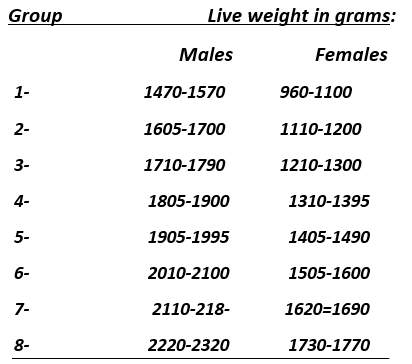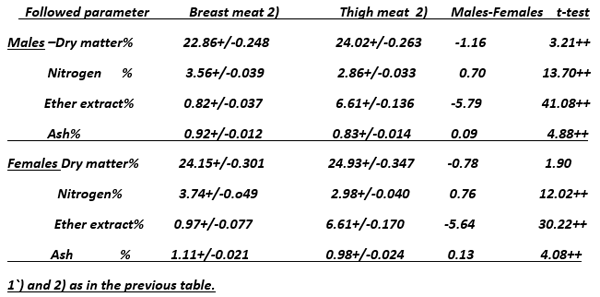The Effect of Growth Intensity and Sex: 2- On the Chemical Composition of Breast and Thigh Meat
Published: January 27, 2014
By: Mostafa Elsabbagh (Animal Production Department-College of Agriculture, Lebanese University)
The main goal of this experiment was to study the factors affecting the chemical composition o the breast and thigh meat of broiler chicks of ROSS RX hybrid of different sexes and live weights at same age.
In an experiment with 150 male and 150 female hybrid broiler chicks ROSSI fed on a litter adlibtum with starter with 22% protein and12.98 MJ ME/Kg and 20% protein and 13.40 MJ ME/Kg as a finisher .It was found from the results of this experiment that the sex of chicks at 49 days of age has a great effect on chemical composition of breast and thigh muscles of both sexes, and that the breast muscle had a higher content of dry matter(1.29%),protein (1.13%)and ash(0.19%),the thigh muscles had a higher content of dry matter, protein and ash(i.e. by0.91,0.75 and 0.15% respectively.
It was found that the thigh muscles of males was affected by the live weight, and no significant differences o live weight on the chemical composition of the breast and thigh muscles.
Feeding, Sex, Age –High live weights-Chemical composition of the breast and thigh muscles.
REVIEW OF LITERATURE
The chemical composition of the meat is defined by the measurement of nutritional constituents found in meat after slaughtering, like moisture, protein, ether extract, carbohydrates, minerals and vitamins.
There are many genetically and environmental factors which affect the chemical composition of the meat.
Reddy et al(192)stated that the moisture content of the carcass meat was significantly higher with males(p<0.01) than females at 10 weeks of age., and the ether extract increased as age advanced.
However, Mandak et al (1985) found that the percentage of dry matter of the meat was affected by sex, since at 49 days of age the dry matter % of males breast was 26.20,26.61, 27.00 and 25.65% while in females it was 25.86, 25.12, 27.17 and 26.07 % in birds fed the same commercial rations.
Pandy et. al, (1985) reported significant differences in the moisture and protein percentage between the males and females of broiler chicks fed on commercial rations, too. The males had a low fat and higher moisture and protein content than females, while females had a higher fat and lower protein and moisture content.
As for the effect of age, Pandy (1988) found that the protein,fat and ashes decreased, the moisture increased with increasing age of both sexes to 8 weeks of age.
Zelenka (1989) studied the proportion of nitrogen in the body weight gains of groups of males and females chicks of ROSS1 from 12th to the 56th of age, and found that at 8 weeks of age the average body mass of females and males was1878 and 2237 grams. Sexual dimorphism in nitrogen retention per unit of gain was significant. The dependence f the N-percentage in gains upon the age of chicks was expressed by means of linear regression equations Y=2.44+0.0208 X and Y=2.29+0 .0275X for the females and males respectively.
And found that the proportion of nitrogen n the gains increased highly significantly during the fattening. In male broilers this increase was higher by nearly one third than in females. This dependence was expressed more exactly y the equation of parabola Y=1.87+0.0589X + 0.000544X2 and
Y=1.38+0.0876X+ 0.00088X2 for females and males resp.
MATERIALS AND METHODS
The biological material used in this experiment originated from the English ROSS I hybrid broiler chicks that fattened under the symbol RX.
The chicks were fattened from 16 January to 11 March .The chicks were selected according to their live weight, the weight of the males varied from 1500 to 2300 grams and the weight of females varied from 960 to 1800 grams.
FEEDING PROGRAM
Chicks were fattened on commercial starter mixture BR1 from one day old to 28 days of age with 22% protein and 12.98 MJ ME/Kg, and from the 28th day to the end of the experiment on finisher mixture BR2 with 20% protein and 13.40 MJ ME/Kg.
Vitamin program was applied:
Chicks’ management: Chicks were selected and divided according to their live weight to 8 groups both for males and females as follows:

Chicks were fattened in pens on deep litter with a stocking density 15.6 chicks/m2, with automatic chained feeders and round automatic waterers.
Lighting program was 24 hours from one to 14 days of age, then decreased to reach 16 hours to the end of the experiment.
At the end of the experiment, chicks were weighed individually, tagged on wings by metal numbers and fasted for 12 hours before slaughtering.
Chemical composition of breast and thigh meat:
The chemical analysis of the thigh and breast meat was as follows:
The breast muscle (m.pectoralis and m.supracoracoideus) and the thigh muscle (m.ilio tibialis posterior) without skin were ground and analyzed by A.O.A.C method to determine the following compounds:
- Percentage of dry matter
- Percentage of nitrogen
- Percentage of ether extract
- Percentage of ash
Evaluation of the results was done by using the t-test, analysis of variance, regression analysis (linear and parabolic functions) according to Snedecor and Cochran.
RESULTS AND DISCUSSION
The following table shows that the differences in breast muscles between males and females broiler chicks ,and the differences in the thigh mat without skin between males and females were significantly (p<0.05-p<0.01)affected by sex,including the dry matter, nitrogen and ash conent.The ether extract in both sexes was practically the same.
Table1: Effect of sex on the chemical composition of breast and thigh meat 1) at 49 days of age

The breast meat of female broilers was higher by 1.29% in dry matter, 1.13% in protein (N><6.25) and 0.15% in ash than the thigh meat of males.
From the point of view of the chemical composition, the nutritive value of the meat of females was significantly better than that of the meat of males. These differences in the chemical percentages were due to the fact that female broilers at 49 days of age already had a higher degree of slaughter ripeness with a lower moisture and higher dry matter, nitrogen, ether extract and ash content in the meat, while male broilers were still in intensive growth and because of that the moisture content in the meat was higher. Similar observations were made by Mandak (1985), Pandy (1985) and others. Reddy et al (1986) and others on the contrary, found that female broilers had a significantly higher ether extract percentage than males.
Table 2- Differences in chemical composition between breast and thigh meat within the same sex at 49 days of age

Table 2 shows more dry matter and ether extract, less nitrogen and ash in thigh meat of chicks of both sexes. With the exception of dry matter in females, all the other constituents were significantly (p<0.01) different. Similar observations were made by Trindade et al (1980) and Uhrin(1985) who found highly significant differences in the chemical composition of thigh and breast meat due to the effect of sex. In males the thigh meat, protein content was lower by 4.4% .the ether extract was higher by 5.8% than in breast meat. The corresponding values in females were 4.8, and 5.6% for protein and ether extract, respectively.
From the dietetic point of view, the breast meat is better, while the thigh meat is preferred by some consumers for its higher juiciness related to the higher ether extract content. Similar observations were made by Pandy et al (1985), Reddy et al (1986) ,Uhrin(1985) and others.
The dependence of percentages of dry matter, nitrogen, ether extract and ash (Y) on the live weight of chicks in grams (X) was expressed by regression equations as in tab-3
Table 3: The dependence of chemical composition of meat on the live weight of chicks in grams-regression equations

With the exception of the ether extract of the thigh meat of males, the regression coefficients in the linear regression equations were not significant.
The parabolic equations were not able to express the dependence better than linear equations with exception of the ether extract content in the thigh meat of males.
With exception of the ether extract in the thigh meat of the males, it may be said that the chemical composition of the breast and thigh meat had no significant relationship with the live weight of the chicks at the same age (49 days).
The ether extract in the thigh meat of males at first decreased to the minimum at 1630 grams of weight and then increased.
Here we notice that no relationship was indicated between the live weight of the males (which varied between 1800 and 2300 grams) and of the females (960 t0 1500 grams) and with the chemical composition of the thigh and breast meat.
Similar observations were made by Reddy et al (1986) ,Seemann (1981) ,Touraille et al(1981) and others.
CONCLUSIONS
In this experiment found that sex affected the chemical composition of breast and thigh muscles of both sexes. The breast and thigh muscles of females, from the point of view of the chemical composition and nutritively, were significantly better because the breast muscle had a higher content of dry matter (1.29%), protein (1.13%) and ash (0.19%), the thigh muscle had a higher content of dry matter, protein and ash 0.91, 0,75 and 0.15% respectively. From the chemical composition´s point of view, the nutritive value of the females meat was significantly better than that the male meat.
In this experiment found that sex affected the chemical composition of breast and thigh muscles of both sexes. The breast and thigh muscles of females, from the point of view of the chemical composition and nutritively, were significantly better because the breast muscle had a higher content of dry matter (1.29%), protein (1.13%) and ash (0.19%), the thigh muscle had a higher content of dry matter, protein and ash 0.91, 0,75 and 0.15% respectively. From the chemical composition´s point of view, the nutritive value of the females meat was significantly better than that the male meat.
From the dietetic point of view the breast was better, while the thigh meat cut is preferred by some consumers for its better juiciness related to a higher content of ether extract.
SUMMARY
In this experiment we followed the effect of sex and live weight of broiler chicks of both sexes at the same age on the chemical composition of the breast and thigh meat.
Chicks of the age 49 days of hybrid combination RX fasted 12 hours before slaughtering were divided according to their live weight into categories differing by 100 grams. The live weight of the females varied from 1000 t0 1300 grams, that of the males from 1500 to 2300 grams.
From each category, 10 chicks were selected for the analysis.
The live weight of the chicks was 1848.0+/-22.87 and 1385.8+/-22.03 grams for males and females, respectively.
No significant differences were reported in the percentage of dry matter ,protein and ash in the muscles in relation to the weight of the chicks before slaughtering.
The percentage of ether extract in the thigh meat of males (Y) increased significantly (p<0.01) with the increasing body weight(X) .The ether extract content in the breast and thigh meat of females appeared to have no relationship with the growth intensity.
The thigh meat had more dry matter and ether extract and less protein and ash than breast muscle, with exception of the dry matter in the females, all the above differences were highly significant (p<0.01).In the thigh meat of females the protein content was lower by 4.6% and the ether extract higher by 5.6%.
With males the thigh meat protein was lower by 4.2%, the ether extract was higher by 5.8% than that of the breast muscle.
Significantly more dry matter, protein and ash was observed in the thigh meat, breast muscle of females than in males.
The ether extract content was virtually the same in both sexes.
From the point of view of dietetic, breast meat is better, while thigh meat will be preferable by some consumers for its higher juiciness related to the higher content of ether extract.
REFERENCES
FARUGA,A.-MROZ,E.:Fattening broiler chickens conventionally and males and females separately .Zesz.nauk.roln.tech.wols.zootech.25:75-83,1983.
GOODWIN, T.L.-ANDREWS, L.D.: The influence of age, sex, energy level on the tenderness of broilers.Poult.Sci48:548-552.1986.
LEESON,S.-SUMMERS,J.:Production and carcass characteristics of the broiler chickens.Poult.Sci.59:786-798.1990.
MANDAK,K.K.-:Effect of energy contents in feed mixtures on fat deposition in broiler chickens.Zivocis.vyr.30:359-365,1985.
MENDES,A.A-CURY,P:Effect of dietary energy levels and sex on broiler performance and carcass traits.Env.Poult.Cnf 24-543-550.1998
REDDYY,G –SIDDIQUE,S.M-MATHUR,C:The effect of strain,sex,age on weight gains, feed efficiency, carcass yields and composition of broilers-Indian Veter.J .59:209-216,1988
SAILER,K-SEEMANN,G:Newere Versuchsergbnisse Zur Broiler Langnost.Lohmann Infor.5-6 ,1986.
SEEMANN,G.:Anmerkungen zur verlangerten Broilermast.Dtsch.Geflugelwirt.38:945-946,1986.
TAN,K.-CHEW,P.C.:Meat,skin and bone yields of broilers. Singapore J.3:12-20, 1988.
TRINDADE, D.S.-OLIVERA, S.C.:Growth rate ,meat composition, and abdominal fat, the effect of dietary energy and feeding program on broilers.Anuario.Tech.Inst.Zootec.9:21-37,1988.
UHRIN, V.-HORVATOVA, N.:A kostne ukazovatele vykrmovej hydiny a gej nutricna hodnota.Zbor.zo.seminara Interz vyroby hydinoveho masa:105-120,1995.
GOODWIN, T.L.-ANDREWS, L.D.: The influence of age, sex, energy level on the tenderness of broilers.Poult.Sci48:548-552.1986.
LEESON,S.-SUMMERS,J.:Production and carcass characteristics of the broiler chickens.Poult.Sci.59:786-798.1990.
MANDAK,K.K.-:Effect of energy contents in feed mixtures on fat deposition in broiler chickens.Zivocis.vyr.30:359-365,1985.
MENDES,A.A-CURY,P:Effect of dietary energy levels and sex on broiler performance and carcass traits.Env.Poult.Cnf 24-543-550.1998
REDDYY,G –SIDDIQUE,S.M-MATHUR,C:The effect of strain,sex,age on weight gains, feed efficiency, carcass yields and composition of broilers-Indian Veter.J .59:209-216,1988
SAILER,K-SEEMANN,G:Newere Versuchsergbnisse Zur Broiler Langnost.Lohmann Infor.5-6 ,1986.
SEEMANN,G.:Anmerkungen zur verlangerten Broilermast.Dtsch.Geflugelwirt.38:945-946,1986.
TAN,K.-CHEW,P.C.:Meat,skin and bone yields of broilers. Singapore J.3:12-20, 1988.
TRINDADE, D.S.-OLIVERA, S.C.:Growth rate ,meat composition, and abdominal fat, the effect of dietary energy and feeding program on broilers.Anuario.Tech.Inst.Zootec.9:21-37,1988.
UHRIN, V.-HORVATOVA, N.:A kostne ukazovatele vykrmovej hydiny a gej nutricna hodnota.Zbor.zo.seminara Interz vyroby hydinoveho masa:105-120,1995.
Authors:
Recommend
Comment
Share

Would you like to discuss another topic? Create a new post to engage with experts in the community.







